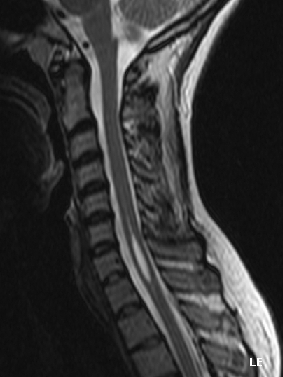WBR0296: Difference between revisions
Jump to navigation
Jump to search
Ochuko Ajari (talk | contribs) No edit summary |
Ochuko Ajari (talk | contribs) No edit summary |
||
| Line 29: | Line 29: | ||
References: First AID for the USMLE Step 1 Pg 127 | References: First AID for the USMLE Step 1 Pg 127 | ||
|AnswerA=[[Ependymoma]] | |AnswerA=[[Ependymoma]] | ||
|AnswerAExp=Incorrect. Ependymoma is a cause of syringomyelia but not the most common cause or associated finding. Ependymomas are also seen with [[Neurofibromatosis type II]] | |||
|AnswerAExp=Incorrect. Ependymoma is a cause of syringomyelia but not the most common cause or associated finding. Ependymomas are also seen with Neurofibromatosis type II | |||
|AnswerB=Chiari II malformation | |AnswerB=Chiari II malformation | ||
|AnswerBExp=Correct. See explanation | |AnswerBExp=Correct. See explanation | ||
| Line 43: | Line 38: | ||
|AnswerDExp=Incorrect. Holoprosencephaly is associated with [[Patau syndrome]], severe [[fetal alcohol syndrome]] and cleft lip/palate | |AnswerDExp=Incorrect. Holoprosencephaly is associated with [[Patau syndrome]], severe [[fetal alcohol syndrome]] and cleft lip/palate | ||
|AnswerE=[[Duodenal atresia]] | |AnswerE=[[Duodenal atresia]] | ||
|AnswerEExp=Incorrect. Duodenal atresia is associated with trisomy 21 and not syringomyelia | |AnswerEExp=Incorrect. Duodenal atresia is associated with trisomy 21 and not syringomyelia | ||
|RightAnswer=B | |RightAnswer=B | ||
|WBRKeyword=Malformations; loss of temperature sensation; loss of pain sensation | |WBRKeyword=Malformations; loss of temperature sensation; loss of pain sensation | ||
|Approved=Yes | |Approved=Yes | ||
}} | }} | ||
Revision as of 13:48, 23 September 2013
| Author | [[PageAuthor::Ogheneochuko Ajari, MB.BS, MS [1]]] |
|---|---|
| Exam Type | ExamType::USMLE Step 1 |
| Main Category | MainCategory::Embryology |
| Sub Category | SubCategory::Neurology |
| Prompt | [[Prompt::A 32-year old male presents to the physician’s office with complaints of progressive numbness of the arms, weakness and hiccups. Past medical history is unremarkable. Physical examination reveals bilateral loss of pain and temperature sensation in the upper extremities, with preservation of touch sensation. What is the most common associated finding of this condition?]] |
| Answer A | [[AnswerA::Ependymoma]] |
| Answer A Explanation | [[AnswerAExp::Incorrect. Ependymoma is a cause of syringomyelia but not the most common cause or associated finding. Ependymomas are also seen with Neurofibromatosis type II]] |
| Answer B | AnswerB::Chiari II malformation |
| Answer B Explanation | AnswerBExp::Correct. See explanation |
| Answer C | [[AnswerC::Thoracolumbar myelomeningocele]] |
| Answer C Explanation | AnswerCExp::Incorrect. Thoracolumbar myelomeningocele is associated with Chiari II malformation and not syringomyelia |
| Answer D | [[AnswerD::Holoprosencephaly]] |
| Answer D Explanation | [[AnswerDExp::Incorrect. Holoprosencephaly is associated with Patau syndrome, severe fetal alcohol syndrome and cleft lip/palate]] |
| Answer E | [[AnswerE::Duodenal atresia]] |
| Answer E Explanation | AnswerEExp::Incorrect. Duodenal atresia is associated with trisomy 21 and not syringomyelia |
| Right Answer | RightAnswer::B |
| Explanation | [[Explanation::This is a case of Syringomyelia and the most commonly associated finding is Chiari II malformation or Arnold-Chiari malformation. The lower part of the cerebellum protrudes from its normal location in the back of the head in the cervical or neck portion of the spinal canal. A syrinx may develop in the cervical region of the spinal cord, interrupting the decussating spinothalamic fibers that mediate pain and temperature sensibility, resulting in the loss of these sensations, while light touch, vibration and position senses are preserved.

Chiari II malformation is the most common associated finding in syringomyelia References: First AID for the USMLE Step 1 Pg 127 |
| Approved | Approved::Yes |
| Keyword | WBRKeyword::Malformations; loss of temperature sensation; loss of pain sensation |
| Linked Question | Linked:: |
| Order in Linked Questions | LinkedOrder:: |